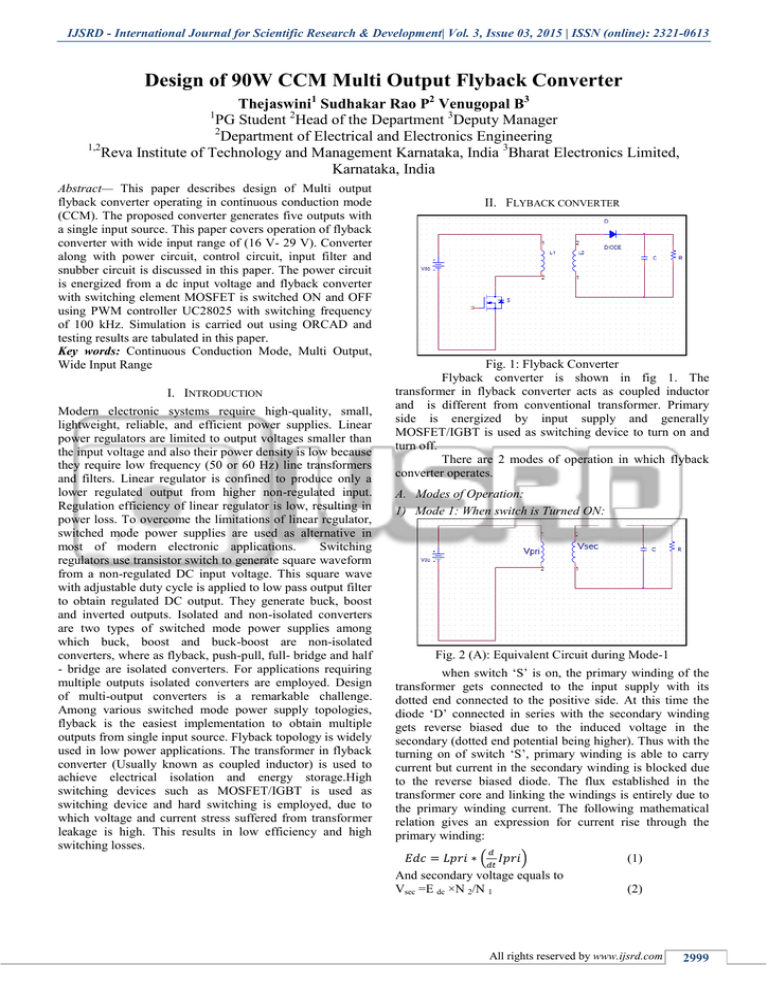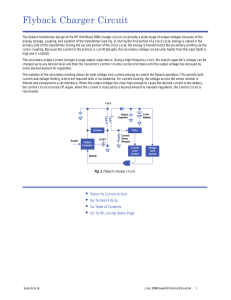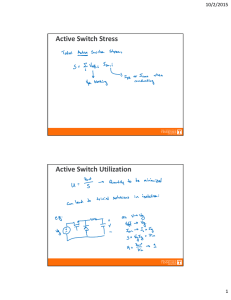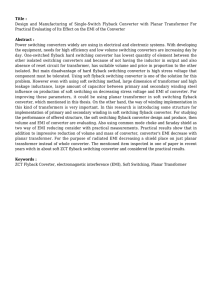
IJSRD - International Journal for Scientific Research & Development| Vol. 3, Issue 03, 2015 | ISSN (online): 2321-0613
Design of 90W CCM Multi Output Flyback Converter
Thejaswini1 Sudhakar Rao P2 Venugopal B3
PG Student 2Head of the Department 3Deputy Manager
2
Department of Electrical and Electronics Engineering
1,2
Reva Institute of Technology and Management Karnataka, India 3Bharat Electronics Limited,
Karnataka, India
1
Abstract— This paper describes design of Multi output
flyback converter operating in continuous conduction mode
(CCM). The proposed converter generates five outputs with
a single input source. This paper covers operation of flyback
converter with wide input range of (16 V- 29 V). Converter
along with power circuit, control circuit, input filter and
snubber circuit is discussed in this paper. The power circuit
is energized from a dc input voltage and flyback converter
with switching element MOSFET is switched ON and OFF
using PWM controller UC28025 with switching frequency
of 100 kHz. Simulation is carried out using ORCAD and
testing results are tabulated in this paper.
Key words: Continuous Conduction Mode, Multi Output,
Wide Input Range
I. INTRODUCTION
Modern electronic systems require high-quality, small,
lightweight, reliable, and efficient power supplies. Linear
power regulators are limited to output voltages smaller than
the input voltage and also their power density is low because
they require low frequency (50 or 60 Hz) line transformers
and filters. Linear regulator is confined to produce only a
lower regulated output from higher non-regulated input.
Regulation efficiency of linear regulator is low, resulting in
power loss. To overcome the limitations of linear regulator,
switched mode power supplies are used as alternative in
most of modern electronic applications.
Switching
regulators use transistor switch to generate square waveform
from a non-regulated DC input voltage. This square wave
with adjustable duty cycle is applied to low pass output filter
to obtain regulated DC output. They generate buck, boost
and inverted outputs. Isolated and non-isolated converters
are two types of switched mode power supplies among
which buck, boost and buck-boost are non-isolated
converters, where as flyback, push-pull, full- bridge and half
- bridge are isolated converters. For applications requiring
multiple outputs isolated converters are employed. Design
of multi-output converters is a remarkable challenge.
Among various switched mode power supply topologies,
flyback is the easiest implementation to obtain multiple
outputs from single input source. Flyback topology is widely
used in low power applications. The transformer in flyback
converter (Usually known as coupled inductor) is used to
achieve electrical isolation and energy storage.High
switching devices such as MOSFET/IGBT is used as
switching device and hard switching is employed, due to
which voltage and current stress suffered from transformer
leakage is high. This results in low efficiency and high
switching losses.
II. FLYBACK CONVERTER
Fig. 1: Flyback Converter
Flyback converter is shown in fig 1. The
transformer in flyback converter acts as coupled inductor
and is different from conventional transformer. Primary
side is energized by input supply and generally
MOSFET/IGBT is used as switching device to turn on and
turn off.
There are 2 modes of operation in which flyback
converter operates.
A. Modes of Operation:
1) Mode 1: When switch is Turned ON:
Fig. 2 (A): Equivalent Circuit during Mode-1
when switch ‗S‘ is on, the primary winding of the
transformer gets connected to the input supply with its
dotted end connected to the positive side. At this time the
diode ‗D‘ connected in series with the secondary winding
gets reverse biased due to the induced voltage in the
secondary (dotted end potential being higher). Thus with the
turning on of switch ‗S‘, primary winding is able to carry
current but current in the secondary winding is blocked due
to the reverse biased diode. The flux established in the
transformer core and linking the windings is entirely due to
the primary winding current. The following mathematical
relation gives an expression for current rise through the
primary winding:
(
)
And secondary voltage equals to
Vsec =E dc ×N 2/N 1
(1)
(2)
All rights reserved by www.ijsrd.com
2999
Design of 90W CCM Multi Output Flyback Converter
(IJSRD/Vol. 3/Issue 03/2015/744)
B. Mode 2: When switch is Turned OFF:
IV. DESIGN STEPS
Fig 2 (B): Equivalent Circuit during Mode-2
Mode-2 of circuit operation starts when switch ‗S‘ is turned
off after conducting for some time. The primary winding
current path is broken and according to laws of magnetic
induction, the voltage polarities across the windings reverse.
Reversal of voltage polarities makes the diode in the
secondary circuit forward biased. Though primary winding
current is interrupted due to turning off of the switch ‗S‘, the
secondary winding immediately starts conducting such that
the net MMF (Magneto motive force) produced by the
windings do not change abruptly. MMF in this case, is the
algebraic sum of the ampere-turns of the two windings.
Primary voltage in this case is:
A. Specifications:
1) Input specification:
Vin Nominal = 28 V
Vin min= 16 V, Vin max = 29 V
Emergency operation: DC steady state voltage
shall be between 16-29 V and is taken care by design.
2) Output Specifications:
V01 = 15 V, 2 A
V02 = 30 V, 1.2 A
V03 = 15 V, 0.9 A
V04 = -15 V, 0.44 A
V05 = 5 V, 0.9 A
3) Dmax limited to 0.44 at 16 V
4) Efficiency = 70%
5) Switching frequency, fs = 100 KHz
6) Ripple voltage = 100 mVp-p (max)
7) Output power = 90.6 W
8) Input power = 129.43 W
B. Turns Ratio:
n=
( )
(3)
And linear decay of secondary current is expressed as:
(
)
(4)
(
) (
)
For Vo = 15 V: n1=
(
) (
)
n1 = 0.61
C. Minimum Primary Inductance:
III. CIRCUIT DIAGRAM AND DESCRIPTION
(
Lmin =
Lmin =
Lmin = 2.21 μH
)
(
)
D. Primary Inductance:
(
)
Lp =
K < 1 for CCM, K= 0.25 for flyback
(
converter
)
Lp =
Lp = 7.65μH
To keep the ∆I minimum, selected Lp= 32.8 μH
E. Transformer Design:
1) Area Product Calculation:
Ap =
Fig. 3: Circuit Diagram of Multi-Output Flyback Converter
The proposed converter generates five different
outputs with single input source. Primary side of transformer
is energized from input DC source (16 V-29 V). MOSFET is
used as switching device operating at 100 KHz switching
frequency. Maximum duty cycle at which converter operates
is 0.45 and ripple voltage is kept below 100 mV. Five
secondaries produce five different outputs viz Vo1 = 15 V, 2
A, Vo2 = 15 V, 0.9 A, Vo3 = 30 V, 1.2 A, Vo4 = 5 V, 0.9 A,
Vo5 = -15 V, 0.44 A. Converter is operating in continuous
conduction mode ( Lp ˃ Lmin). Large spikes which appear
across switch due to presence of leakage inductance is
suppressed by RCD snubber connected across MOSFET.
Input filter is used to prevent input source from being
corrupted and to reduce EMI.
Where Ip is primary peak current, Irms is primary
rms current,
Kw is winding factor = 0.3, J is current density = 4*106 A/m,
Bm is maximum flux density = 0.2 T.
Ap=
Ap= 23006.13 mm4
Select a core having area product greater than
23006.13 mm4.
2) Selection of Core:
Selected core EE55/25/21 N87
Area product Ap= Ac*Aw
= 354mm2*234.3mm2
Ap = 82942.2 mm4
3) Calculation Of Number Of Primary Turns:
[
Np = [
]
]
All rights reserved by www.ijsrd.com
3000
Design of 90W CCM Multi Output Flyback Converter
(IJSRD/Vol. 3/Issue 03/2015/744)
[
=
]
[
]
= 8 turns
4) Calculation of Number of Secondary Turns:
(
Ns =
(
=
)
)
= 10 turns
5) Calculation of Secondary Inductance:
Ls =
=(
Fig 6: Output Voltages
)
= 88.15 μH
6) Calculation of Output Capacitance:
Co1 =
[
(
[
[
]
)]
]
=
= 150 μF
7) Voltage across Switch:
Vsw =
*
( )+
=
*
( )+
Vsw= 26 V
MOSFET selected is IRFP150A
Vds= 100V
Id = 40A
V. SIMULATION CIRCUIT AND WAVEFORMS
Fig 7: Output Currents
VI. CONCLUSION
The flyback converter is designed and implemented for the
given specifications. The converter was designed for input
range of 16 V to 29 V AC input voltage range, with 5
multiple outputs, 90.6 W full load output power and output
voltage ripple less than 100 mV. The converter designed is
shown to work satisfactorily within given limits maintaining
constant regulated output with minimal ripple. The load
regulation is shown to be very low, hence demonstrating the
converter‘s ability to account for variations in supply
voltage and load to maintain constant(regulated) output. The
circuit is simulated using ORCAD and the relevant
waveforms are obtained.
VII. ACKNOWLEDGMENT
Fig. 4: Simulation Circuit of Multi-Output Flyback
Converter
I express my sincere gratitude to PROF. SUDHAKAR RAO
P, Head of Department, Electrical and Electronics
Engineering, REVA ITM for his encouragement, valuable
suggestions and motivation to work with this project. I am
highly indebted to MR.VENGOPAL B, Deputy Manager
(CD & E, POWER SUPPLY DEPT), BHARAT
ELECTRONICS LIMITED, BENGALURU, for his
valuable guidance and constant supervision as well as for
providing necessary information regarding the project and
also for his constant support in completing the project. The
blessing help and guidance given by him time to time shall
carry me a long way in the journey on which I am about to
embark.
REFERENCES
Fig. 5: Gate Pulses
[1] Dongwon Kwon, Graduate Student Member, IEEE,
and Gabriel A. Rincón-Mora, Senior Member,
IEEE,―Single-Inductor–Multiple-Output Switching
DC–DC Converters,‖ IEEE transactions on circuits
and systems—ii: express briefs, vol. 56, no. 8, august
2009.
All rights reserved by www.ijsrd.com
3001
Design of 90W CCM Multi Output Flyback Converter
(IJSRD/Vol. 3/Issue 03/2015/744)
[2] R. J. Wai and R. Y. Duan, ―High step-up converter
with coupled inductor,‖ IEEE Trans. Power
Electron., vol. 20, no. 5, pp. 1025–1035, Sep. 2005.
[3] Abraham I. Pressman, Keith Billings, Taylor Morey,
„Switching Power Supply Design, Mc Graw Hill, 3rd
Edition 2009.
[4] Daniel W. Hart, Introduction to Power Electronics,
Prentice Hall, 1997.
[5] Ned Mohan, Tore M Undeland, William P. Robbins,
„Power Electronics Converter, Applications, and
Design, 3rd EDITION Wiley India Edition, 2011.
All rights reserved by www.ijsrd.com
3002






